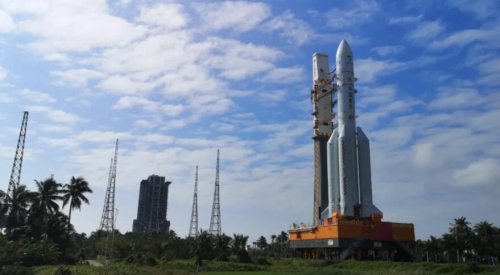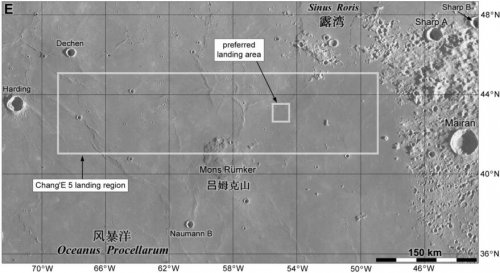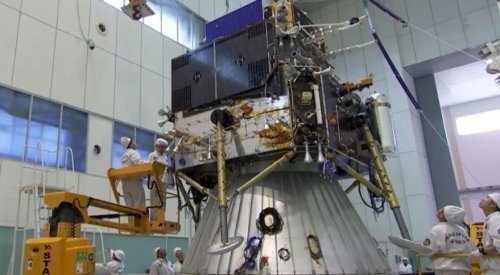HELSINKI — China has rolled out a Long March 5 heavy-lift rocket in preparation for launch of the complex Chang’e-5 lunar sample return mission early next week.
The roughly 878-metric-ton heavy-lift Long March 5 was vertically transferred from an assembly building to its launch area late Monday Eastern in a process that took around two hours.
Launch of the 8.2-metric-ton Chang’e-5 spacecraft from the coastal Wenchang Satellite Launch Center is now expected Nov. 24 local time. State media reports have so far only confirmed the launch will take place in late November.
A successful mission would make China only the third country to deliver lunar samples to Earth, after the U.S. Apollo crewed program and Soviet robotic Luna missions of the 1960s and 1970s.
Launch preparations at Wenchang have been ongoing since mid-September. The fourth and mostly recent Long March 5 mission rocket successfully launched the Tianwen-1 Mars spacecraft in July.
The Failure of the second Long March 5 launch in July 2017 meant a delay of three years for Chang’e-5, having been scheduled to launch later that year.
Mission landing site, time frame
The Chang’e-5 landing will target a site close to Mons Rümker, a volcanic formation situated in the Oceanus Procellarum region of western edge of the near side of the moon.contains geological units as young as around 1.21 billion years old. By comparison samples brought to Earth by Apollo astronauts are aged between 3.1 and 4.4 billion years old.
Sunrise over Mons Rümker will occur November 27, ahead of the landing attempt. The mission seeks to collect around 2 kilograms of samples by both drilling to a depth of up to two meters and scooping up surface material.
Unlike China’s ongoing, multi-lunar-day Chang’e-4 spacecraft which is equipped with radioisotope heater units to survive the extreme cold of lunar night, the Chang’e-5 landing and sampling needs to take place within a single, roughly 14-Earth-day lunar daytime.
After sampling, a complex ascent, automated lunar orbit rendezvous and transfer of materials involving separate ascent and service modules will take place. The service module will then return to Earth followed by a high-velocity reentry into Earth’s atmosphere by a return capsule.
The mission is expected to last around 23 days from launch until landing in Siziwang Banner, Inner Mongolia, around Dec. 16-17. Samples will then be transferred to specially developed facilities for handling, analyzing and storing the lunar material.
The selected landing area for the Chang’e-5 lunar sample return. Credit: Phil Stooke
Greater challenges
Chang’e-5 is the third phase of the Chinese lunar exploration project formulated in the early 2000s. Orbiters Chang’e-1 and 2 and subsequent landing and roving missions Chang’e-3 and 4 marked the first two stages.
Yu Dengyun, deputy chief designer of China’s lunar exploration program, told state media in September that the mission is much more challenging than previous missions.
New challenges include the sampling and following stages. “The gravity on the Moon is different from that on the Earth, about one sixth. And under such a circumstance, how to package samples is a key issue of the mission. We have never tried that before,” Yu said.
“We usually completed the rocket launching on the Earth at a fixed point. We have a proven technique in this field. But we still have difficulties in the liftoff of the ascend vehicle, which is expected to happen on the lander…we have never tried this before,” said Yu.
Chang’e-6 is a sample return spacecraft engineered at the same time as Chang’e-5 to provide a backup in the event of failure. Success of the latter would however see Chang’e-6 repurposed for a landing at the lunar south pole around 2023.
China has stated it will then proceed into an extended phase of lunar exploration involving Chang’e-7 and further lunar landing missions. The aim will be to establish an ‘international lunar research station’ in the mid-to-late 2020s as a precursor to crewed landings.
Sample return technology and experience developed through Chang’e-5 is also to be utilized for planned near Earth asteroid and Mars sample return missions later in the decade. The complexity of the Chang’e-5 mission profile is considered by observers to be related to future crewed lunar landing ambitions.
China’s Chang’e-5 spacecraft stack undergoing testing. Credit: CCTV/framegrab
- China is quietly preparing for November launch of the Chang’e-5 lunar sample return mission
- Long March 5B rolled out for crewed spacecraft, space station test launch
- Crunch time: Rocket companies in all-out battle for Air Force award
- The long road to Vostochny: Inside Russia’s newest launch facility
- SpaceX takes top honors in SpaceNews Awards for Excellence & Innovation
Share with your friends



(0) Comments
This article comments are currently no :(